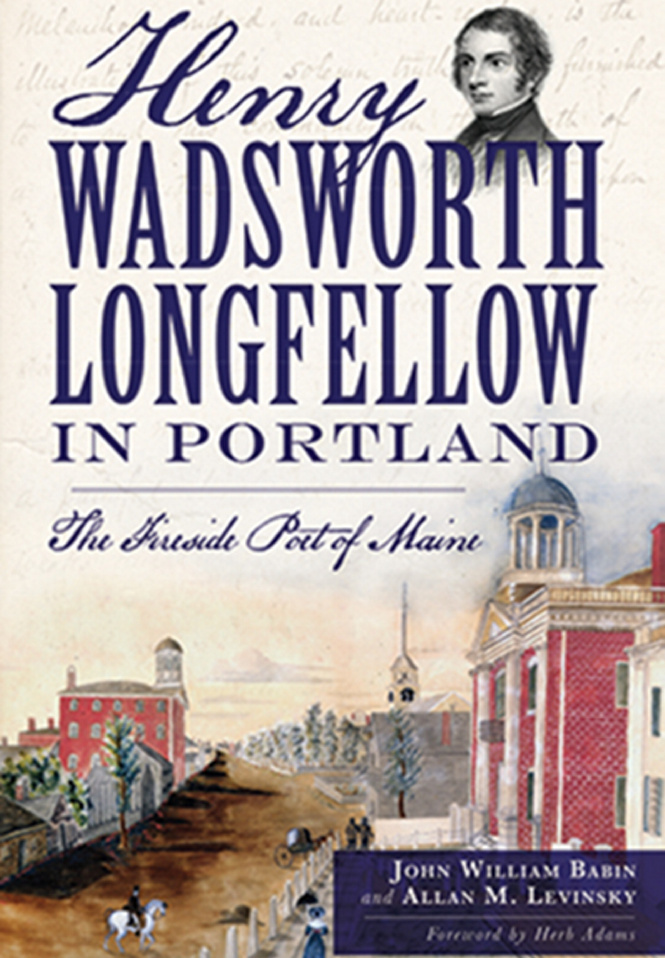In the passage of two centuries, there have been bushels of publications devoted to Henry Wadsworth Longfellow (1807-1882), Victorian America’s most noted writer of verse. In quality these studies have ranged from the amateurish and pietistical to professional, soul-searching biographies and volumes of his fascinating correspondence. A new book, “Henry Wadsworth Longfellow: The Fireside Poet of Maine,” by John Babin and Allan Levinsky, offers what is to my knowledge, the best concise and well-illustrated introduction to the poet, his family and connections to Maine.
It is written by tour guides and docents of the Wadsworth-Longfellow House, headed by visitor services manager Babin. Joining him with their intimate views of the house and its workings are tour guides Levinsky and Judie Percival. Celebrated regional historian and sometime-guide Herb Adams wrote the eloquent foreword. (Disclosure: The Maine Historical Society runs the Wadsworth-Longfellow House. This reviewer works part-time at Maine Historical’s Brown Library. This volume was not a Maine Historical imprint, nor were the society’s scholars involved in its writing.)
Adams proclaims, “America has never forgotten Longfellow and he never forgot the Portland home – a home, in every sense – that framed his life and made his memories warm. The family called the house the ‘Old Original.’ Thoughtful workers here are lucky people. Visitors can still find the past, but also the future, if they look quietly enough.”
Docents have been steering tourists, school children and the occasional celebrity, such as horror writer H.P. Lovecraft, through the doorway and into the rooms and hallways since the Maine Historical Society took responsibility in 1907. In their way, the guides have been transformed into the new inhabitants, paying close attention to well documented facts, physical changes and personalities and opinions of newcomers. Here, too, the writers of “Henry Wadsworth Longfellow in Portland” show their readers through the rooms and halls, offering them the thoughts of new visitors and past guests.
As Longfellow wrote in “Haunted Houses”: “So from this world of spirits there descends/ A bridge of light, connecting it with this,/ O’er whose unsteady floor, that sways and bends,/Wander our thoughts above the dark abyss.” By looking quietly, the readers of this book become part of the passing parade of this nation’s hopes, fears, failures and triumphs from the War of 1812 to the 9/11 disaster.
The book, richly illustrated and well written, is divided into Adams’ foreword, an introduction by Levinsky, an appendix by Percival and eight chapters of text by Babin focused on the birth of the poet, growing up during the colorful War of 1812, the achievement of Maine statehood, life and work at Bowdoin and Harvard Colleges and sister Anne Longfellow Pierce’s last years in the mansion.
Helping to visualize this story of family and community are illustrated objects, including portraits, deeds, and a map based on a sketch by Anne of her childhood neighborhood that includes the location of a windmill on the ledge above Brown Street and Avenue. Now the house is surrounded by great commercial structures that have grown over time. Images, including landscape paintings, photographs, banners, childhood play things and souvenir kitsch, tell the ongoing and colorful tale in a fresh way.
What sets this volume apart from others is a comingling of past and present, the living and the dead. Academics would probably not have employed this delightful mix of high-style and pedestrian objects and certainly not in such a sprightly yet accurate way.
My only quibble concerns incomplete captions. For example, a photograph of Henry’s first published poem “The Battle of Lovell’s Pond” does not give the date of publication or credit to the Portland Gazette. Fuller explanations throughout the text would make an excellent book even better.
William David Barry is a local historian who has authored/co-authored seven books, including “Maine: The Wilder Side of New England” and “Deering: A Social and Architectural History.”
Send questions/comments to the editors.



Success. Please wait for the page to reload. If the page does not reload within 5 seconds, please refresh the page.
Enter your email and password to access comments.
Hi, to comment on stories you must . This profile is in addition to your subscription and website login.
Already have a commenting profile? .
Invalid username/password.
Please check your email to confirm and complete your registration.
Only subscribers are eligible to post comments. Please subscribe or login first for digital access. Here’s why.
Use the form below to reset your password. When you've submitted your account email, we will send an email with a reset code.